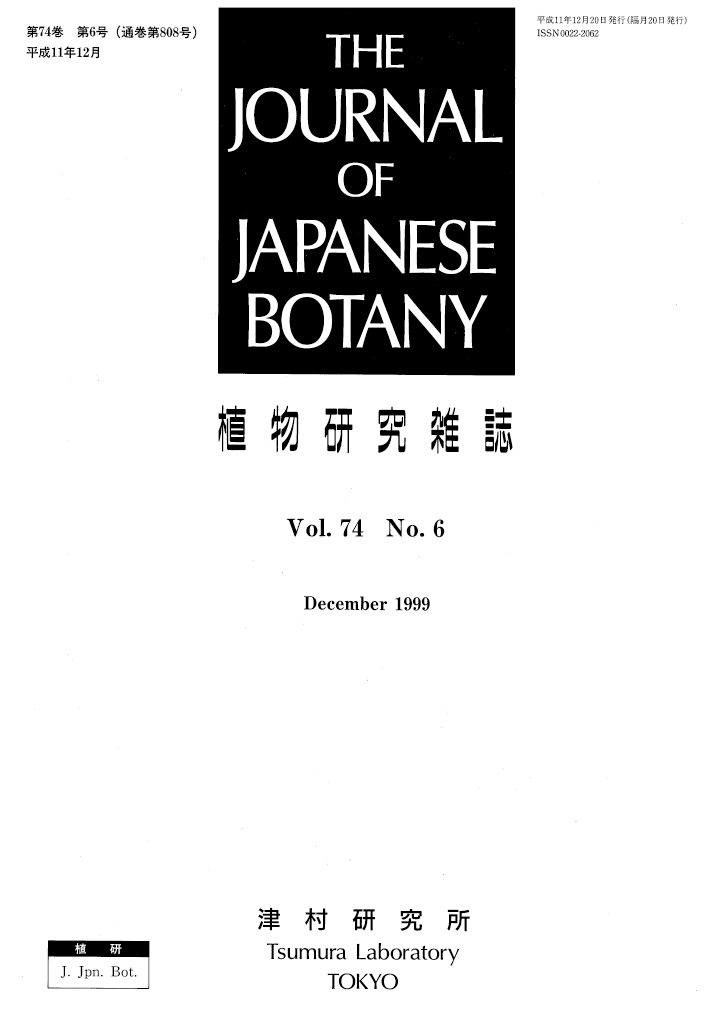
- Issue 6 Pages 321-
- Issue 5 Pages 261-
- Issue 4 Pages 191-
- Issue 3 Pages 127-
- Issue 2 Pages 63-
- Issue 1 Pages 1-
- |<
- <
- 1
- >
- >|
-
Article type: cover
1999Volume 74Issue 6 Article ID: 74_6_9376
Published: December 20, 1999
Released on J-STAGE: October 21, 2022
JOURNAL FREE ACCESSDownload PDF (134K) -
Noriyuki TANAKAArticle type: Originals
1999Volume 74Issue 6 Pages 321-328
Published: December 20, 1999
Released on J-STAGE: October 21, 2022
JOURNAL FREE ACCESSOphiopogon revolutus F.T.Wang & L.K.Dai is treated as conspecific with O. griffithii (Baker) Hook.f. Ophiopogon griffithii is variable especially in leaf shape and width. This species is new to Myanmar. It is noteworthy that Ophiopogon kradungensis M.N.Tamura shares several similar features with O. griffithii .
View full abstractDownload PDF (914K) -
Koji YONEKURA, Hiroyoshi OHASHIArticle type: Originals
1999Volume 74Issue 6 Pages 329-343
Published: December 20, 1999
Released on J-STAGE: October 21, 2022
JOURNAL FREE ACCESSPlants hitherto referred to Bistorta milletii H.Lév. in Nepal are different from the typical B. milletii described from SW. China. The Nepalese plants include two distinct species. One should be called as Bistorta confusa (Meisn.) Greene, which has been overlooked or misapplied to different species in prevoius works, and is growing in eastern to central Nepal eastward from Kali Gandaki Valley. The other is a new species, Bistorta rubra Yonekura & H.Ohashi, and is distributed from northern India to western Nepal westward from Kali Gandaki Valley. Bistorta rubra is considered to be related to B. sherei H.Ohba & S.Akiyama in central to eastern Nepal. Bistorta milletioides H.Ohba & S.Akiyama, distinct from the above taxa, is proved to be distributed in central to eastern Nepal.
View full abstractDownload PDF (1031K) -
Koichi UEHARAArticle type: Originals
1999Volume 74Issue 6 Pages 344-352
Published: December 20, 1999
Released on J-STAGE: October 21, 2022
JOURNAL FREE ACCESSThe morphogenesis of the microspore wall in Selaginella tamariscina was examined using transmission electron microscopy. The sporoderm of S. tamariscina consists of three layers: the endospore, exospore, and perispore. The endospore is the thick, innermost layer, which has a low electron density. The exospore consists of three distinct sub-layers. The innermost sub-layer consists of several sheets of tripartite lamellae (lamellar layer). It is located on the proximal face of the microspore. The middle sub-layer is a uniform, thick, homogeneous layer (inner homogeneous layer). The outermost sub-layer is even thicker, conspicuously sculptured, and also consists of homogeneous material (outer homogeneous layer). The layers of the exospore begin to form just after meiosis in that order. The endospore forms at the same time as the outer homogeneous layer. Finally, the perispore is deposited on the exospore. The perispore is an electron-opaque layer that is tightly attached to the surface of the exospore. The endospore and the exospore lamellar layer appear to be derived from the cytoplasm of the microspore, while the inner and outer homogeneous layers of the exospore and the perispore are derived from the tapetum.
View full abstractDownload PDF (1107K) -
Su-Juan LIN, Masahiro KATO, Kunio IWATSUKIArticle type: Originals
1999Volume 74Issue 6 Pages 353-366
Published: December 20, 1999
Released on J-STAGE: October 21, 2022
JOURNAL FREE ACCESSSpore morphology of twenty species including two varieties of the genus Lindsaea was observed with scanning electron microscopy. Spores were trilete and lobed in all species observed except for the L. odorata complex. There were inter- and intraspecific differences in two-layered perispore, and the sculptural elements of the inner and outer perispore in different combinations. The species characters of spore morphology were recognized in 12 species here. The lumina on inner layer and rodlet deposition of outer layer were observed in L. chienii, but verrucose sculpture and grapnelte of the two layers in L. orbiculata. These characters are significant for inferring the features of these two species. The irregular spore form and variable perispore structure strongly suggest hybrid origins of L. javanensis and L. heterophylla. Monolete and ellipsoidal spores were observed in the L. odorata complex. The variation in the spore size is in relation to the ploidy of cytotypes.
View full abstractDownload PDF (1616K) -
Koji YONEKURAArticle type: Notes
1999Volume 74Issue 6 Pages 367-368
Published: December 20, 1999
Released on J-STAGE: October 21, 2022
JOURNAL FREE ACCESSDownload PDF (165K) -
[in Japanese]Article type: Book review
1999Volume 74Issue 6 Pages 368
Published: December 20, 1999
Released on J-STAGE: October 21, 2022
JOURNAL FREE ACCESSDownload PDF (98K) -
[in Japanese]Article type: Book review
1999Volume 74Issue 6 Pages 368-369
Published: December 20, 1999
Released on J-STAGE: October 21, 2022
JOURNAL FREE ACCESSDownload PDF (193K) -
[in Japanese]Article type: Book review
1999Volume 74Issue 6 Pages 369
Published: December 20, 1999
Released on J-STAGE: October 21, 2022
JOURNAL FREE ACCESSDownload PDF (101K) -
[in Japanese]Article type: Book review
1999Volume 74Issue 6 Pages 369
Published: December 20, 1999
Released on J-STAGE: October 21, 2022
JOURNAL FREE ACCESSDownload PDF (101K) -
[in Japanese]Article type: Book review
1999Volume 74Issue 6 Pages 369
Published: December 20, 1999
Released on J-STAGE: October 21, 2022
JOURNAL FREE ACCESSDownload PDF (101K) -
Article type: index
1999Volume 74Issue 6 Article ID: 74_6_9387
Published: December 20, 1999
Released on J-STAGE: October 21, 2022
JOURNAL FREE ACCESSDownload PDF (858K)
- |<
- <
- 1
- >
- >|